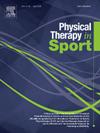Analysis of musculoskeletal injuries in elite female soccer players: Cohort study in one Brazilian team
IF 2.2
3区 医学
Q1 REHABILITATION
引用次数: 0
Abstract
Purpose
The objectives of this study were to identify if preseason assessment variables predict lower limb musculoskeletal injuries in female soccer players and to compare characteristics between injured and non-injured athletes.
Design
4-month retrospective cohort study.
Setting
An elite women's soccer team from Brazil.
Participants
Twenty-seven female soccer players.
Main outcomes measures
Lower limb length and asymmetry, hamstring flexibility, isokinetic strength of the hamstrings and quadriceps, single hop, lunge test, mSEBT, Thomas, trunk mobility, hip adductor strength, Bent-knee fall-out for testing hip range of motion, lateral trunk flexor endurance, Hip Sit, and single-leg and countermovement jump were recorded at baseline. Logistic regression analyses were performed to identify predictors for the occurrence of lower limb musculoskeletal injuries.
Results
The logistic regression showed a significant model for lower limb musculoskeletal injuries. Trunk mobility, Hip Sit test, and were associated with injury (p = 0.016; R2 = 0,589). The model correctly classified 84.8% of cases (84.6% sensitivity and 85% specificity). The area under the receiver operating characteristic curve was 0.68 (95% CI: 0.53, 0.83; P < 0.024) demonstrating acceptable discriminative ability.
Conclusion
The model showed that trunk mobility, Hip Sit, and Bent-knee fall-out were predictors of lower limb musculoskeletal injuries in female soccer players.
优秀女足运动员肌肉骨骼损伤分析:一支巴西队的队列研究
目的本研究的目的是确定季前赛评估变量是否预测女性足球运动员下肢肌肉骨骼损伤,并比较受伤和未受伤运动员的特征。设计:4个月的回顾性队列研究。来自巴西的精英女子足球队。参与者:27名女足球运动员。主要结果测量:下肢长度和不对称性、腘绳肌柔韧性、腘绳肌和股四头肌的等速力量、单跳、弓步测试、mSEBT、Thomas、躯干活动度、髋关节内收肌力量、测试髋关节活动范围的屈膝跌倒、侧躯干屈肌耐力、髋关节坐、单腿和反动作跳跃在基线记录。进行逻辑回归分析以确定下肢肌肉骨骼损伤发生的预测因素。结果logistic回归分析显示下肢肌肉骨骼损伤模型具有显著性。躯干活动度、髋关节坐位测试与损伤相关(p = 0.016;r2 = 0.589)。该模型正确分类了84.8%的病例(敏感性84.6%,特异性85%)。受试者工作特征曲线下面积为0.68 (95% CI: 0.53, 0.83;P & lt;0.024)表现出可接受的辨别能力。结论该模型显示,躯干活动度、髋关节坐位和屈膝跌倒是女子足球运动员下肢肌肉骨骼损伤的预测因子。
本文章由计算机程序翻译,如有差异,请以英文原文为准。
求助全文
约1分钟内获得全文
求助全文
来源期刊

Physical Therapy in Sport
医学-康复医学
CiteScore
4.50
自引率
8.30%
发文量
125
审稿时长
39 days
期刊介绍:
Physical Therapy in Sport is an international peer-reviewed journal that provides a forum for the publication of research and clinical practice material relevant to the healthcare professions involved in sports and exercise medicine, and rehabilitation. The journal publishes material that is indispensable for day-to-day practice and continuing professional development. Physical Therapy in Sport covers topics dealing with the diagnosis, treatment, and prevention of injuries, as well as more general areas of sports and exercise medicine and related sports science.
The journal publishes original research, case studies, reviews, masterclasses, papers on clinical approaches, and book reviews, as well as occasional reports from conferences. Papers are double-blind peer-reviewed by our international advisory board and other international experts, and submissions from a broad range of disciplines are actively encouraged.
 求助内容:
求助内容: 应助结果提醒方式:
应助结果提醒方式:


